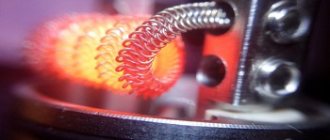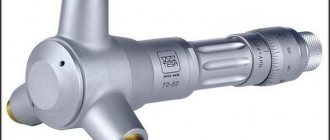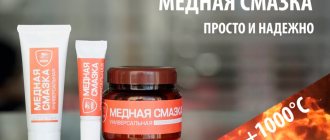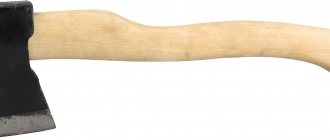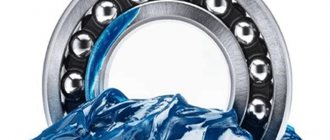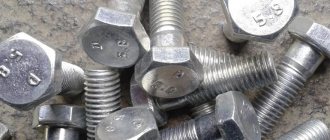Graphite grease - an inorganic lubricant, black or dark brown in color, with a dense and highly viscous consistency. Outwardly it resembles the well-known solid oil. The lubricant is made from vegetable fats using petroleum cylinder oil fluids and lithium or calcium soaps, as well as graphite. Graphite powder is used as the latter. In accordance with GOST 3333-80, according to which it is manufactured, the optimal temperature of use is from -20°C to +60°C, but in fact it can withstand more critical temperatures. Graphite lubricant is widely used in industry, as well as in automobile transport. In particular, it is used to coat springs, suspension elements, heavily loaded bearings, open gears, and so on.
Composition of graphite grease
First of all, you need to know that in the technical literature the concept of “graphite lubricant” can be understood as various compositions. The fact is that initially this definition refers to an inorganic lubricant for which graphite is used as a thickener, but in a broad sense this is also the name for lubricants where graphite is used as an additive. Thus, the term “graphite lubricant” may mean:
Crushed graphite
- ordinary graphite powder, which can be used as a solid lubricant;
- soap-based lubricant containing graphite;
- graphite suspension in oil solution (inorganic lubricant).
It is the latter composition that is most often called graphite lubricant and will be discussed further. Its manufacturing technology involves thickening viscous organic or synthetic oil, which is obtained from petroleum products, with calcium soap and graphite powder. In other words, we can say that graphite powder is added to classic grease, which gives the lubricant its properties.
Graphite powder itself has a soft consistency. Therefore, as part of the lubricant, it fills irregularities on the working surfaces of parts, thus reducing friction.
Currently, copper-graphite grease can also be found on sale. Copper powder has been added to its composition. It is able to withstand high temperatures. Typically, copper-graphite lubricant is available in the form of aerosols. Looking ahead, we will say that this composition is often applied to the caliper guides. This will prevent the discs and/or brake drums from sticking to the hub flanges.
Graphite USSA
Graphite lubricants, originally produced for lubricating parts of low-speed mechanisms, are becoming increasingly widespread in technology due to their unique properties.
The characteristics of graphite lubricant are determined by the components of which it is composed. The composition of graphite lubricant (outdated name “graphite USsA”) in Soviet times was established by GOST 3333-80.
A simplified description of its manufacture looks something like this: a synthetic or organic viscous oil (derived from petroleum) is thickened by adding calcium soap and graphite powder. To simplify it as much as possible, solid oil is mixed with crushed graphite.
Graphite (crushed carbon), which forms the basis of graphite lubricant, is able to fill microscopic irregularities in parts, while reducing friction.
The use of a material such as graphite in the lubricant is not accidental - it was used to reduce friction between parts 300 years ago. Graphite, as you know, is nothing more than carbon (coal), but in a more “loose” state, as a result of which it is able to fill microscopic irregularities in parts (scratches, cavities, marks from cutting and processing tools, etc. ).
This “smoothing” of surfaces significantly reduces the coefficient of friction. Solid oil provides liquid friction of parts - in general, it works like any other lubricant, but in combination with graphite, it allows the latter to remain in the friction zone of parts - shafts, gears, etc.
Properties of graphite grease
Graphite itself is a good conductor of heat and electricity, is not destroyed by moisture, is not affected by static electricity, and is also thermally stable (can withstand high temperatures). The corresponding lubricant also has all these properties, although to a lesser extent.
What is good about graphite lubricant? Its advantages include:
- chemical resistance (when lubricant is applied to working surfaces, its elements do not react chemically with it);
- thermal stability (does not evaporate up to a temperature of +150°C, since the concentration of volatile substances in its composition is minimal, and does not lose its performance characteristics at high temperatures);
- protects work surfaces from moisture;
- has increased colloidal stability;
- explosion-proof;
- has excellent lubricating properties;
- increases wear resistance, mechanical performance and service life of the mechanism where it is used;
- minimizes the number of jams;
- not affected by oil, that is, remains on the surface even if it is present;
- graphite lubricant adheres perfectly to any surface;
- resistant to static electricity;
- has high adhesive and anti-friction properties.
Another important advantage of graphite lubricant is its low price with satisfactory performance characteristics . Although, in fairness, it should be noted that currently there are many other, more advanced lubricants that, although more expensive, have better performance.
However, graphite lubricant also has disadvantages. In particular, it cannot be used in mechanisms with high operating precision, since solid impurities present in graphite will contribute to increased wear of parts;
Types of bicycle bearing grease
Lubricants are of the following types:
- Consistent. This type is thick. They have a long service life and a wide range of temperature tolerance. However, difficulties arise during application, as well as during removal of excess. Another drawback is that they often collect a large amount of dust.
- Liquid. They are easy to handle bearings with a grease gun. You can use a syringe. Excess is simply removed with a rag. Disadvantage: sometimes drips appear due to the liquid consistency and inexperience in processing, as well as changes in viscosity during changes in ambient temperature.
- Two-component. The advantage is the precise application of the liquid type. The aerosol tends to penetrate into hard-to-reach parts of the bearing. Disadvantage: the aerosol may get past the desired location. Therefore, after finishing the treatment, you will have to wait until the constituent substance has completely evaporated.
Characteristics
The current GOST 3333-80, as well as the corresponding technical conditions, indicate the technical and operational characteristics of graphite lubricant.
| Characteristic | Meaning |
| Temperature range of application | from -20°С to +60°С (however, it is allowed to use lubricant at temperatures below -20°С in springs and similar devices) |
| Density, g/cm³ | 1,4…1,73 |
| Dropping point | not lower than +77°С |
| Penetration at +25°C with stirring (60 double strokes) | not less than 250 mm/10 |
| Colloidal stability, % of released oil | no more than 5 |
| Mass fraction of water | no more than 3% |
| Shear strength at +50°C | not less than 100 Pa (1.0 gf/cm²) |
| Viscosity at 0°C at an average strain rate gradient of 10 1/s | no more than 100 Pa•s |
| Tensile strength at +20°С, kg/cm² | |
| tensile | 120 |
| for compression | 270…600 |
| Electrical resistance | 5030 ohm•cm |
| Temperature, °C | |
| decomposition | 3290 |
| maximum permissible operating | 540 |
| average permissible operational | 425 |
| Lubricant oxidation products | CO, CO2 |
| NLGI class | 2 |
| Designation according to GOST 23258 | Ska 2/7-g2 |
When working with lubricant, you must remember and follow the rules below for the safe use of graphite lubricant.
When working with lubricant, observe the following safety and fire safety rules:
- Graphite grease is explosion-proof, its flash point is +210°C.
- If a spill occurs on the surface, the lubricant should be collected in a container, the spill area should be wiped dry with a rag, which should then be placed in a separate, preferably metal, box.
- In the event of a fire, the main fire extinguishing agents are used: finely sprayed water, chemical, air-chemical foam, high-expansion foam and appropriate powder compositions.
The guaranteed shelf life of the lubricant is five years from the date of manufacture.
Graphite as a filler
Graphite has been successfully used as a component of greases thickened with calcium, lithium or sodium soaps. Possessing a layered crystallographic lattice, it is an excellent anti-friction filler, which significantly improves the lubricating properties of the product, wear resistance of the lubricant and mechanical properties.
Graphite lubricant has a great advantage - durability. When the protective oil film stops working and breaks, solid graphite particles protect the surface of the assembly from boundary friction, thereby increasing the service life of the part and reducing the number of mechanism jams.
Graphite lubricants advantageously combine increased heat resistance, chemical neutrality, and good adhesive and antifriction properties. In addition, for example, the price of lithium grease with the addition of graphite is not so high, although the lubrication efficiency increases significantly.
It is recommended to store the lubricant in closed containers, avoiding direct exposure to sunlight.
https://mapsol.ru/%D0%B3%D1%80%D0%B0%D1%84%D0%B8%D1%82%D0%BE%D0%B2%D0%B0%D1%8F-% D1%81%D0%BC%D0%B0%D0%B7%D0%BA%D0%B0 Where is graphite lubricant used?
Considering the fact that many parts require lubrication to maintain functionality, technologists and engineers are constantly introducing developments that help to significantly increase the working life.
Graphite lubricant remains one of the most commonly used products in production, which has a number of advantages over other lubricants:
- Forms a colloidal framework on parts;
- Retains in areas where oil leaks;
- Actively used among heavily loaded mechanisms.
Application area
The scope of application of graphite lubricant is very wide. In production it is lubricated with:
- special equipment springs;
- low-speed bearings;
- open and closed shafts;
- various gears;
- shut-off valves;
- suspensions in large-sized mechanisms, special equipment;
- drilling rig supports.
Now we will briefly list the components and mechanisms of the car that can be lubricated with this composition (taking into account some features):
- steering joints;
- steering rack (in particular, the rack body is disassembled and the working gear is lubricated);
- elements of the steering mechanism (with the exception of those where transmission oils are used as lubricant);
- ball joints;
- anti-squeak washers in springs;
- anthers of steering tips and rods;
- support bearings;
- steering knuckle bearings (for prevention, grease is also packed into a protective cap);
- cable drive of the parking brake;
- car springs;
- on rear-wheel drive vehicles it can be used for driveshaft crosspieces.
Graphite lubricant can also be used as a prophylactic agent. In particular, it can be used to lubricate threaded connections, ordinary and car locks in summer and especially in winter .
Many car enthusiasts are also interested in the question of whether it is possible to lubricate CV joints (constant velocity joints) with graphite. There is no clear answer in this case. If we are talking about cheap domestic lubricant, then you should not risk it, it can ruin the internal mechanism of the hinge. If you use imported expensive lubricant (for example, Molykote BR2 plus, Molykote Longterm 2 plus, Castrol LMX and other materials containing graphite), then you can try. However, remember that there are special lubricants for CV joints.
CV joint lubrication
Timely lubrication of the CV joint reduces its wear and extends its service life. Each type of hinge requires its own type of lubricant. Find out which one needs to be smeared and which is better from reviews and a review of characteristics. More details
Do not forget that graphite lubricant is intended for use in low-speed mechanisms and where greater precision is not required.
It is worth dwelling separately on the question of whether it is possible to lubricate battery terminals with graphite grease. Yes, its composition conducts electricity, but there is a risk of overheating due to the fact that it has a high resistivity. Therefore, it is possible to use “graphite” to lubricate the terminals, but it is not advisable . The lubricant will prevent the surface from corroding. Therefore, it is better to use other means to lubricate the battery terminals.
How to lubricate battery terminals
Lubricants for battery terminals can range from traditional “old-fashioned” ways to protect battery terminals from oxidation, to modern ones, with impurities that improve electrical conductivity. More details
How to remove graphite grease
Using lubricant without care can easily stain your clothes. And it will no longer be easy to remove it, because it is not only grease, but also graphite, which is difficult to wipe off. Therefore, a very interesting question arises: what can you use to wash or wipe off graphite grease. There are many different debates and opinions on this matter on the Internet. We offer your opinion several remedies that should help with this (the fact is that in each individual case different remedies can help, it all depends on the degree of contamination, type of fabric, duration of contamination, additional impurities, and so on). So, they will help you:
Antipyatin
- gasoline (preferably 98, or pure aviation kerosene);
- grease remover (for example, Antipyatin);
- "Sarma gel" for dishes;
- contactless shampoo for car washing (spray the aerosol onto dirt, then try to gently wipe off);
- hot soapy solution (if the contamination is not severe, you can soak the clothes for a while in a solution of laundry soap, and then scrub them by hand);
- “Vanish” (similarly, you need to pre-soak the clothes and let them stand for several hours; you can wash them by hand or in a washing machine).
Some car owners recommend washing clothes in a washing machine at maximum temperature. Remember that this is not acceptable for some types of fabrics! They may lose their structure and the clothing cannot be restored. Therefore, read what is indicated on the corresponding label on the clothing, in particular, at what temperature the product can be washed.
What are they and what are they used for?
Graphite relish improves the operating properties of the mechanism and increases its service life.
There are several types (generations) of graphite lubricants. The principle of their operation is the same, but the composition is slightly different to achieve certain properties. The first graphite lubricants were used more than a century ago. They were used in rather rough and large mechanisms - hinges, supports and other heavy parts. The first lubricants were made based on coarse graphite.
On the one hand, such lubricants were easy to manufacture and unpretentious to use, but on the other hand, they were not good enough for thinner mechanisms.
At the beginning of the twentieth century, grease, an improved graphite lubricant, came into everyday use. Its difference from the previous generation of lubricants was that the grease was more plastic. It was not washed out with water and could withstand a wider range of temperatures - from twenty degrees below zero to seventy degrees above zero. Thanks to this, solid oil has found wide application in industry. In addition, it is still used in agricultural machinery and cars.
Solid oil is produced by thickening industrial oils with fatty or synthetic acids, so its production process is quite simple and the cost is low.
Solid oil.
Now the scope of application of solid oil lubricants has narrowed somewhat due to the fact that new specialized lubricants have appeared that work better than solid oil (Litol-24, Fiol, CV joint and others). However, new types of graphite lubricants have begun to be produced in many countries.
For example, graphite lubricant with molybdenum disulfide is sold in Russia and the CIS, and it is used to lubricate individual vehicle components. There are also specialized graphite-based lubricants for bicycles and other mechanisms.
Solidol is the most common graphite lubricant in Russia. In terms of its properties, it is between the first generation graphite lubricants and the new lubricants, so everything that is said in relation to solid oil can be equally applied to other types of graphite lubricants. There are small differences, but they are not so striking.
How to make graphite grease with your own hands
DIY graphite lubricant
Due to the popularity of graphite lubricant among auto repairmen, as well as the simplicity of its composition, there are several traditional methods by which you can make this lubricant at home.
You need to take graphite powder, solid oil and machine oil. Their ratio may be different. The basis is liquid oil, to which grease is added, and then graphite (you can use ground pencil lead or worn brushes of an electric motor or current collector). Next, this mass must be stirred until a consistency similar to sour cream is obtained. Instead of machine oil, you can use transmission oil.
However, it is necessary to understand that homemade mixtures will not meet the stated GOST, therefore such lubricants will not meet its standards. In addition, the shelf life of homemade graphite lubricants will be significantly lower than the factory one.
What is better: graphite lubricant or pennant?
The composition of the base is the same, except that the Vympel zinc grease does not use an organic thickener, mainly lithium soap. The consumer characteristics are similar, the fundamental difference is in the operating range.
Graphite grease is not as heat resistant: peak values from +120℃ to +150℃ are allowed, but only for a short time. Zinc grease “Vympel” stably maintains its characteristics up to a temperature of +120℃.
Can bearings be lubricated with graphite grease? Only at low load and low speed. At the same time, “Vympel” is placed in loaded rotation bearings and moving suspension parts without restrictions.
Copper-graphite grease
As mentioned above, an improved version of the classic graphite grease is copper-graphite grease. From the name it is clear that copper powder has been added to its composition, which significantly improves its performance properties. Features of the composition of copper-graphite lubricant include:
Copper-graphite grease
- ability to work at high temperatures (in this case it is impossible to indicate a clear range, since there are different compositions on the market with different properties, some of them are able to work at temperatures of about +1000°C and above, read the details in the description of the product);
- ability to withstand high mechanical loads (similar to the previous point);
- increased level of adhesion and stickiness;
- complete elimination of corrosion formations on protected surfaces;
- resistance to oil and moisture;
- The lubricant does not contain lead, nickel and sulfur.
Thus, copper-graphite lubricant perfectly protects working surfaces even under extreme operating conditions. Often, threaded connections are treated with this product before connecting them. This makes it possible to unscrew the connection in the future without any problems.
Popular manufacturers
Finally, let’s briefly look at some domestic manufacturers producing graphite lubricant. It’s worth saying right away that their products are largely similar to each other, so it doesn’t really matter what brand of lubricant you buy. Domestic graphite lubricant meets GOST 3333-80, so all products will be approximately the same.
According to old Soviet standards, graphite lubricant had the designation “USsA”.
So, in the post-Soviet space the production of graphite lubricant is carried out by:
- LLC "Colloidal-graphite preparations". This company produces graphite lubricants for production. Provides wholesale deliveries.
- Oil Right. As of the end of 2022, a tube weighing 100 grams costs 40 rubles. The product catalog number is 6047.
- TPK "RadioTechPayka". A jar of 25 grams costs 30 rubles, a tube weighing 100 grams costs 70 rubles, and a jar weighing 800 grams costs 280 rubles.
As for foreign manufacturers, their products have a more advanced composition. As a rule, in addition to graphite, the products contain modern additives and elements that improve their performance. In this case, their description does not make sense, firstly, because the choice must be made based on the goal facing the consumer, and secondly, the number of lubricants and manufacturers is simply enormous!
Instead of a conclusion
Graphite lubricant is a cheap and effective means for protecting working surfaces from corrosion, increasing the performance characteristics of working pairs, as well as increasing their working life. However, when using it, remember that the lubricant cannot be used in high-speed mechanisms and where high precision is required from the working surfaces. So use it in the areas mentioned above and, given its low price, it will serve you well in protecting your vehicle's parts.
Bicycle lubricants: types
There are certain types of lubricant for bicycle bearings:
- Two-component. Characterized by precise application. Gets into hard-to-reach places. For greater effect, after lubrication, you must wait until it evaporates completely.
- Liquid. Convenient to combine with an oil can. Any excess can be removed with a cloth. There may be drips and changes in the density of the substance (the reason is the temperature difference).
- Consistent. The lubricant is quite thick. It lasts a long time and responds well to temperature fluctuations. It is problematic to apply and remove excess lubricant. Collects a lot of dust.
Greases
Greases are quite flexible and are sold in cans and tubes. Suitable for slow rotating parts. Used for lubricating all types of bicycle bearings and preserving chains.
Types of greases:
- lithium oils;
- those. petrolatum;
- graphite lubricant;
- calcium oils.
Lithium oils
Features and Specifications:
- has a reddish or yellow tint;
- contains lithium;
- used to improve sliding or increase the amplitude of permissible temperature;
- operates at temperatures from -50 to +180°C.
The most suitable oils (from a domestic manufacturer) for bicycles are Ciatim and Litol.
Grease No. 158
Features and Specifications:
- high adhesive property;
- operates within a temperature range from -40 to +120°C;
- bluish tint;
- is a good thickener;
- ideal cleaning of bearings.
Technical Vaseline
Features and Specifications:
- possible damage to the chrome layer of the bearings;
- poor cleaning of Vaseline itself (compared to medical grade);
- lasts a long time and can be applied to any bicycle parts;
- no transparency brown or yellowish color;
- serves as good protection against air, rust and water.
Graphite lubricant
Features and Specifications:
- contamination occurs upon collision with graphite;
- the main component is oil;
- USSA grease is suitable for lubricating threads or bushings;
- promotes sliding of bearing parts.
Calcium oils
features and characteristics:
- good “adhesion” to metal;
- operates within a temperature range from -30 to +50°C;
- makes the metal yellowish;
- domestically produced oils “Unial” and “Solidol” are suitable for bicycle parts in contact with water;
- not compatible with bushings equipped with a braking mechanism;
- Suitable for all types of metals.
Liquid oils
Sold in different containers: small canisters, oil bottles and barrels. They come in varying degrees of thickness. A few drops are enough to renew the lubricated part.
To avoid damage to the tire rubber, you need to ensure that there is no leaking excess. The lubrication procedure must be repeated once every two to three weeks or after rain (or other prolonged/noticeable contact with water).
Two-component lubricants
The containers in which this lubricant is produced are of two types: oil bottles and aerosols. The oil in the lubricant is thinner. Almost indispensable when working with parts consisting of several parts. A bicycle bearing is an excellent example of such a part.
Excellent protection against water, forming an oily film.
Silicone lubricant
Features and Specifications:
- refuses powerful resistance to pollution;
- convenient method of application;
- silicone will not harm the rubber parts of the bicycle
Teflon grease
Features and Specifications:
- good resistance to abrasion;
- remains in its original form for a long time;
- repels dust;
- Ideal for bicycle chain.
Wax lubricant
Features and Specifications:
- for new lubrication, you need to clean the part from the previous layer;
- no need for frequent lubrication;
- does not hold well when pressure increases;
- forms a relatively thick layer.
